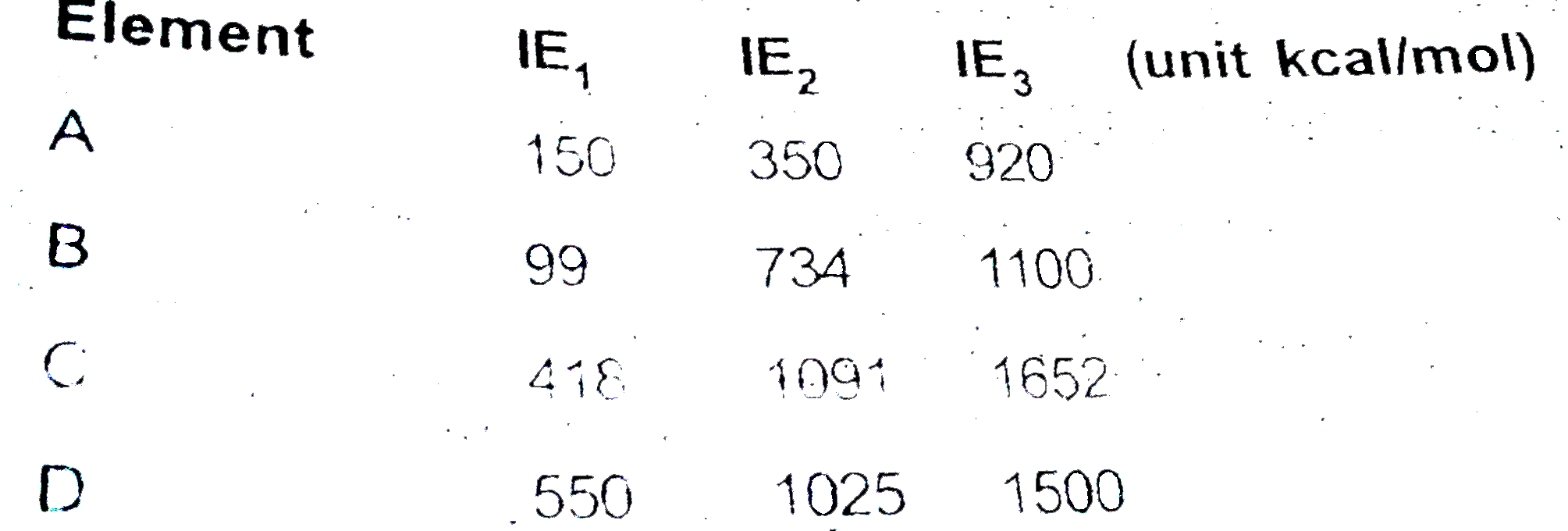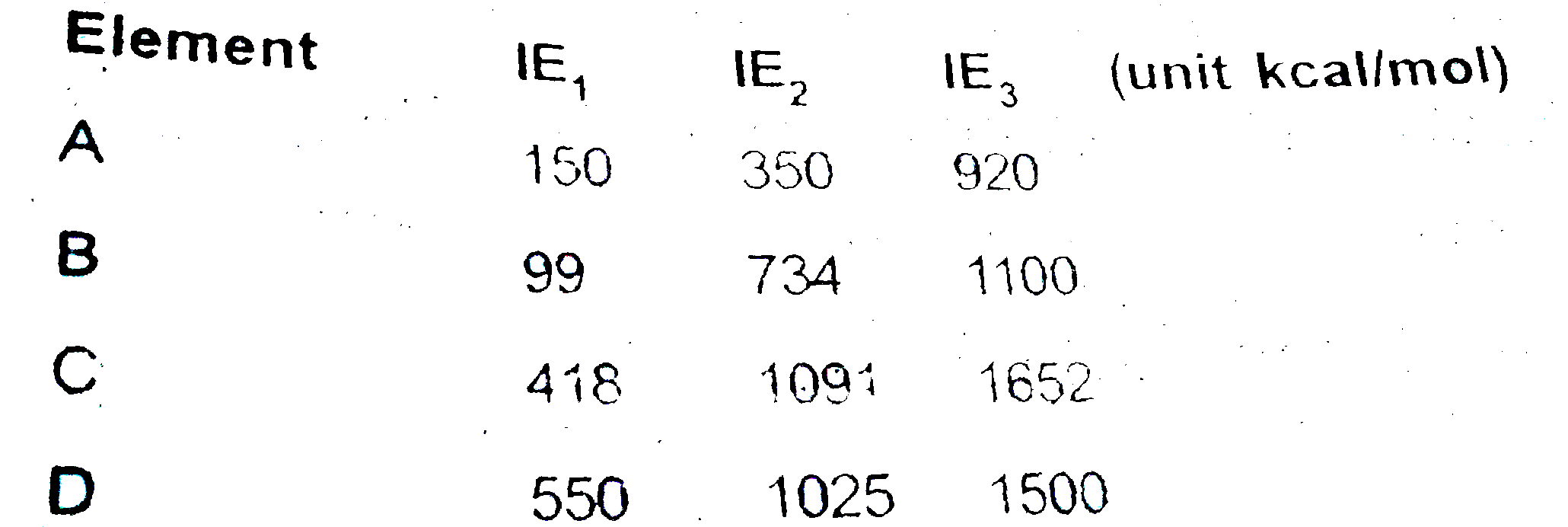Ionisation energy is the amount of energy required to remove the outermost e− from a gaseous atom. It's unit is kJ/mole or kcal/mole.
Successive ionisation energy - It is the amount of energy required to remove electron successively from a gaseous ion. These are termed as IE2,IE3,IE4 etc. the difference in the values of IE1,IE2 and IE3 helps to determine electronic configuration of the element.

Which element is a noble gas ?
A
B
C
D
The correct Answer is:D
Step by step video & image solution for Ionisation energy is the amount of energy required to remove the outermost e^(-) from a gaseous atom. It's unit is kJ/mole or kcal/mole. Successive ionisation energy - It is the amount of energy required to remove electron successively from a gaseous ion. These are termed as IE_(2), IE_(3), IE_(4) etc. the difference in the values of IE_(1), IE_(2) " and " IE_(3) helps to determine electronic configuration of the element. Which element is a noble gas ? by Chemistry experts to help you in doubts & scoring excellent marks in Class 12 exams.
Updated on:21/07/2023Topper's Solved these Questions
- CLASSIFICATION OF ELEMENTS AND PERIODICITY IN PROPERTIESBOOK - AAKASH INSTITUTECHAPTER - CLASSIFICATION OF ELEMENTS AND PERIODICITY IN PROPERTIESEXERCISE - Assignment (Section -E assertion-Reason Type Questions)
14 Videos
- CLASSIFICATION OF ELEMENTS AND PERIODICITY IN PROPERTIESBOOK - AAKASH INSTITUTECHAPTER - CLASSIFICATION OF ELEMENTS AND PERIODICITY IN PROPERTIESEXERCISE - Assignment (Section -F Matrix-Match Type Questions)
1 Videos
- CLASSIFICATION OF ELEMENTS AND PERIODICITY IN PROPERTIESBOOK - AAKASH INSTITUTECHAPTER - CLASSIFICATION OF ELEMENTS AND PERIODICITY IN PROPERTIESEXERCISE - Assignment (Section -C)
12 Videos
- CHEMISTRY IN EVERYDAY LIFE BOOK - AAKASH INSTITUTECHAPTER - CHEMISTRY IN EVERYDAY LIFE EXERCISE - Assignment ( SECTION - A)
45 Videos
- COORDINATION COMPOUNDS BOOK - AAKASH INSTITUTECHAPTER - COORDINATION COMPOUNDS EXERCISE - Assignment (Section-J Aakash Challenger Questions )
10 Videos
Similar Questions
Ionisation energy is the amount of energy required to remove the outermost e− from a gaseous atom. It's unit is kJ/mole or kcal/mole.
Successive ionisation energy - It is the amount of energy required to remove electron successively from a gaseous ion. These are termed as IE2,IE3,IE4 etc. the difference in the values of IE1,IE2 and IE3 helps to determine electronic configuration of the element.

Which element forms stable unipositive ion ?
View SolutionIonisation energy is the amount of energy required to remove the outermost e− from a gaseous atom. It's unit is kJ/mole or kcal/mole.
Successive ionisation energy - It is the amount of energy required to remove electron successively from a gaseous ion. These are termed as IE2,IE3,IE4 etc. the difference in the values of IE1,IE2 and IE3 helps to determine electronic configuration of the element.

Which of the following is a non-metal ?
View Solution
Knowledge Check
Highest amount of energy will be required for the removal of electron from
As-subshellBp-subshellCd-subshellDf-subshellIf 13.6 eV energy is required to ionise the hydrogen atom, then energy required to remove an electron from n=3 is :
A9 eVB6.8 eVC3.4 eVD1.5 eVThe value of IE1,IE2,IE3 and IE4 of an atom are respectively 7.5eV,25.6eV,48.6eV and 170.6eV. The electronic configuration of the atom will be
A1s2,2s22p6,3s1B1s22s22p63s23p1C1s2,2s22p63s23p3D1s2,2s22p63s2
With the help of Bohr 's model , calculate the second ionisation energy of helium (energy required to remove the electron from He⊕
View SolutionHow much energy is required to ionise a H - atom if the electron occupie n=5 orbit ? Compare your answer with the ionization energy of H-atom (energy required to remove the electron from nth orbit ).
View SolutionThe amount of energy required to remove the most loosely bound electron from an isolated gaseous atom is called as first ionization energy (IE1). Similarly the amount of energies required to knock out second, third etc. electrons from the isolated and IE3>IE2>IE1.
(i) Nuclear charge (ii) Atomic size (iii) penetration effect of the electrons (iv) shielding effect of the inner electrons and (b) electronic configurations (exactly half filled and completely filled configurations are extra stable) are the important factors which affect the ionisation energies. Similarly, the amount of energy released when a neutral isolated gaseous atom accepts an extra electron to from gaseous anion is called electron affinity.
(X(g)+e−(g)→X−(g)+ energy
A positive elecrton affinity idicates that the ion X− has a lower more negative energy than the neutral atom X. The second electron affinity for the addition of a second electron to an initially neutral atom is negative because the electron replusion outweights the nuclear attraction, e.g.,
O(g)+e−Exothermic−−−−−−→O−(g),Ea=+141kJmol− ....(i)
O−(g)+e−Excothermic−−−−−−→,Ea=−780kJmol− ...(ii)
The electron affinity of an element depends upon (i) atomic size (ii) nuclear charge and (iii) electronic configuration. In general, in a group, ionisation energy and electron affinity decrease as the atomic size increases. The members of third period have some higher (e.g., S and Cl) electron affinity values than the members of second period (e.g., O and F) because second period elements have very small atomic size. Hence, there is tendency of electron-electron repulsion, which resultss in less evolution of energy in the formation of correcsponding anion.
The first ionisation energy of Na,Mg,AI and Si are in the order of:
View SolutionThe amount of energy required to remove the most loosely bound electron from an isolated gaseous atom is called as first ionization energy (IE1). Similarly the amount of energies required to knock out second, third etc. electrons from the isolated and IE3>IE2>IE1.
(i) Nuclear charge (ii) Atomic size (iii) penetration effect of the electrons (iv) shielding effect of the inner electrons and (b) electronic configurations (exactly half filled and completely filled configurations are extra stable) are the important factors which affect the ionisation energies. Similarly, the amount of energy released when a neutral isolated gaseous atom accepts an extra electron to from gaseous anion is called electron affinity.
(X(g)+e−(g)→X−(g)+ energy
A positive elecrton affinity idicates that the ion X− has a lower more negative energy than the neutral atom X. The second electron affinity for the addition of a second electron to an initially neutral atom is negative because the electron replusion outweights the nuclear attraction, e.g.,
O(g)+e−Exothermic−−−−−−→O−(g),Ea=+141kJmol− ....(i)
O−(g)+e−Excothermic−−−−−−→,Ea=−780kJmol− ...(ii)
The electron affinity of an element depends upon (i) atomic size (ii) nuclear charge and (iii) electronic configuration. In general, in a group, ionisation energy and electron affinity decrease as the atomic size increases. The members of third period have some higher (e.g., S and Cl) electron affinity values than the members of second period (e.g., O and F) because second period elements have very small atomic size. Hence, there is tendency of electron-electron repulsion, which resultss in less evolution of energy in the formation of correcsponding anion.
Which one of the following statements is incorrect in relation to ionisation enthalpy?
View SolutionThe amount of energy required to remove the most loosely bound electron from an isolated gaseous atom is called as first ionization energy (IE1). Similarly the amount of energies required to knock out second, third etc. electrons from the isolated and IE3>IE2>IE1.
(i) Nuclear charge (ii) Atomic size (iii) penetration effect of the electrons (iv) shielding effect of the inner electrons and (b) electronic configurations (exactly half filled and completely filled configurations are extra stable) are the important factors which affect the ionisation energies. Similarly, the amount of energy released when a neutral isolated gaseous atom accepts an extra electron to from gaseous anion is called electron affinity.
(X(g)+e−(g)→X−(g)+ energy
A positive elecrton affinity idicates that the ion X− has a lower more negative energy than the neutral atom X. The second electron affinity for the addition of a second electron to an initially neutral atom is negative because the electron replusion outweights the nuclear attraction, e.g.,
O(g)+e−Exothermic−−−−−−→O−(g),Ea=+141kJmol− ....(i)
O−(g)+e−Excothermic−−−−−−→,Ea=−780kJmol− ...(ii)
The electron affinity of an element depends upon (i) atomic size (ii) nuclear charge and (iii) electronic configuration. In general, in a group, ionisation energy and electron affinity decrease as the atomic size increases. The members of third period have some higher (e.g., S and Cl) electron affinity values than the members of second period (e.g., O and F) because second period elements have very small atomic size. Hence, there is tendency of electron-electron repulsion, which resultss in less evolution of energy in the formation of correcsponding anion.
Identify the least stable ion amongst the following:
View Solution
